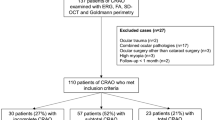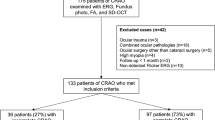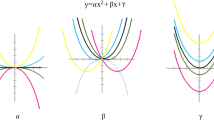Abstract
Background
To evaluate the prognostic value of interocular amplitude ratio of flicker electroretinogram (ERG) in determining the development of neovascularization in patients with central retinal vein occlusion (CRVO).
Methods
We retrospectively reviewed the data obtained from flicker ERG in 51 CRVO patients. Of these, 22 eyes which had enough follow-up to differentiate ischemic CRVO from nonischemic CRVO were included for data analysis. The flicker ERG was recorded at a 30 Hz frequency after dark adaptation, and ten sweeps were averaged.
Results
Eleven eyes were ischemic and 11 eyes were nonischemic. Three amplitude parameters had the potential to explain the type of CRVO. They were amplitude of lesion eye (p = 0.0001), interocular difference of amplitude (p < 0.0001), and interocular ratio of amplitude (p < 0.0001). Both an interocular amplitude difference of −23 μV and interocular amplitude ratio of 60% were very good cutoff points to differentiate ischemic from nonischemic CRVO. Receiver operating characteristic curve analysis revealed that each of the two cutoff values had a sensitivity and specificity of 100%.
Conclusions
Interocular comparison of amplitude is a good solution for avoiding the variability of ERG. An interocular amplitude ratio of flicker ERG of 60% is a succinct, useful parameter in clinical practices for differentiating ischemic from nonischemic CRVO.

Similar content being viewed by others
References
Breton ME, Quinn GE, Keene SS, Dahmen JC, Brucker AJ (1989) Electroretinogram parameters at presentation as predictors of rubeosis in central retinal vein occlusion patients. Ophthalmology 96:1343–1352
Breton ME, Montzka DP, Brucker AJ, Quinn GE (1991) Electroretinogram interpretation in central retinal vein occlusion. Ophthalmology 98:1937–1944
Breton ME, Schueller AW, Montzka DP (1991) Electroretinogram b-wave implicit time and b/a wave ratio as a function of intensity in central retinal vein occlusion. Ophthalmology 98:1845–1853
Gouras P, MacKay J (1992) Supernormal cone electroretinograms in central retinal vein occlusion. Invest Ophthalmol Vis Sci 33:508–515
Hayreh SS (1983) Classification of central retinal vein occlusion. Ophthalmology 90:458–74
Hayreh SS, Klugman MR, Podhajsky P, Kolder HE (1989) Electroretinography in central retinal vein occlusion. Correlation of electroretinographic changes with pupillary abnormalities. Graefes Arch Clin Exp Ophthalmol 227:549–561
Hayreh SS, Klugman MR, Beri M, Kimura AE, Podhajsky P (1990) Differentiation of ischemic from non-ischemic central retinal vein occlusion during the early acute phase. Graefes Arch Clin Exp Ophthalmol 228:201–217
Jonas JB, Harder B (2007) Ophthalmodynamometric differences between ischemic vs nonischemic retinal vein occlusion. Am J Ophthalmol 143:112–116
Johnson MA, Marcus S, Elman MJ, McPhee TJ (1988) Neovascularization in central retinal vein occlusion: Electroretinographic findings. Arch Ophthalmol 106:348–352
Johnson MA, McPhee TJ (1993) Electroretinopraphic findings in iris neovascularization due to acute central retinal vein occlusion. Arch Ophthalmol 111:806–814
Kjeka O, Bredrup C, Krohn J (2007) Photopic 30 Hz flicker electroretinography predicts ocular neovascularization in central retinal vein occlusion. Acta Ophthalmol Scand 85:640–643
Larsson J, Andreasson S, Bauer B (1998) Cone b-wave implicit time as an early predictor of rubeosis in central retinal vein occlusion. Am J Ophthalmol 125:247–249
Larsson J, Bauer B, Cavallin-Sjoberg U, Andreasson S (1998) Fluorescein angiography versus ERG for predicting the prognosis in central retinal vein occlusion. Acta Ophthalmol Scand 76:456–460
Larsson J, Bauer B, Andreasson S (2000) The 30-Hz flicker cone ERG for monitoring the early course of central retinal vein occlusion. Acta Ophthalmol Scand 78:187–190
Larsson J, Andreasson S (2001) Photopic 30 Hz flicker ERG as a predictor for rubeosis in central retinal vein occlusion. Br J Ophthalmol 85:683–685
Matsui Y, Katsumi O, Mehta MC, Hirose T (1994) Correction of electroretinographic and fluorescein angiographic findings in unilateral central retinal vein obstruction. Graefes Arch Clin Exp Ophthalmol 232:449–457
Morrell AJ, Thompson DA, Gibson JM, Kritzinger EE, Drasdo N (1991) Electroretinography as a prognostic indicator of neovascularization in CRVO. Eye 5:362–368
Matsui Y, Katsumi O, Sakaue H, Hirose T (1994) Electroretinogram b/a wave ratio improvement in central retinal vein obstruction. Br J Ophthalmol 78:191–198
Matsui Y, Katsumi O, McMeel JW, Hirose T (1994) Prognostic value of initial electroretinogram in central retinal vein obstruction. Graefes Arch Clin Exp Ophthalmol 232:75–81
Sabates R, Hirose T, McMeel JW (1983) Electroretinopraphy in the prognosis and classification of central retinal vein occlusion. Arch Ophthalmol 101:232–235
Sakaue H, Katsumi O, Hirose T (1989) Electroretinographic findings in fellow eyes of patients with central retinal vein occlusion. Arch Ophthalmol 107:1459–1462
Severns ML, Johnson MA, Merritt SA (1991) Automated estimation of implicit time and amplitude from the flicker electroretinogram. Appl Optics 30:2106–2112
Severns ML, Johnson MA (1993) Predicting outcome in central retinal vein occlusion using the flicker electroretinogram. Arch Ophthalmol 111:1123–1130
Severns ML, Johnson MA (1993) The variability of the b-wave of the electroretinogram with stimulus luminance. Documenta Ophthalmologica 84:291–299
The Central Vein Occlusion Study Group (1997) Natural history and clinical management of central retinal vein occlusion. Arch Ophthalmol 115:486–491
Williamson TH, Keating D, Bradnam M (1997) Electroretinography of central retinal vein occlusion under scotopic and photopic conditions: what to measure? Acta Ophthalmol Scand 75:48–53
Author information
Authors and Affiliations
Corresponding author
Additional information
The authors have no proprietary or financial interest in any product mentioned in this manuscript.
The authors have full control of all primary data, and agree Graefe's Archive for Clinical and Experimental Ophthalmology to review these data upon request.
Rights and permissions
About this article
Cite this article
Kuo, HK., Kuo, MT., Chen, YJ. et al. The flicker electroretinogram interocular amplitude ratio is a strong prognostic indicator of neovascularization in patients with central retinal vein occlusion. Graefes Arch Clin Exp Ophthalmol 248, 185–189 (2010). https://doi.org/10.1007/s00417-009-1205-4
Received:
Revised:
Accepted:
Published:
Issue Date:
DOI: https://doi.org/10.1007/s00417-009-1205-4




